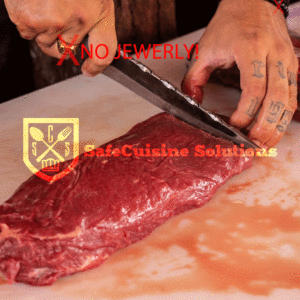
Cross-contamination is a significant concern in the culinary industry, posing risks to the safety and well-being of both customers and staff. It occurs when harmful bacteria, viruses, or allergens are transferred from one surface or food item to another, compromising food safety. In this blog post, we will delve into the importance of cross-contamination prevention and share practical tips to help you safeguard against foodborne illnesses in your culinary establishment.
Understanding Cross-Contamination
Cross-contamination can happen at various stages of food handling, from preparation to serving. It can occur through direct contact, such as using the same cutting board or knife for different food items, or indirectly, such as when utensils or surfaces come into contact with contaminated hands or surfaces. By being aware of potential sources of cross-contamination, you can take proactive measures to prevent it and ensure the safety of your customers.
Practical Tips for Cross-Contamination Prevention:
- Separate Food Categories: Designate separate areas and utensils for handling different food categories, such as raw meats, poultry, seafood, and ready-to-eat foods. This separation minimizes the risk of harmful bacteria transferring from raw to cooked or ready-to-eat items. Use color-coded cutting boards, utensils, and storage containers to visually differentiate between food types and ensure that each item has its designated space.
- Proper Hand Hygiene: Encourage and enforce proper hand hygiene practices among your staff. Emphasize the importance of thorough handwashing before and after handling different food items, after using the restroom, and after touching potentially contaminated surfaces. Provide readily accessible handwashing stations equipped with soap, warm water, and single-use towels. In addition, remind your staff to avoid touching their face, hair, or other surfaces unnecessarily.
- Cleaning and Sanitizing: Regularly clean and sanitize all surfaces, utensils, and equipment to eliminate any potential sources of contamination. Use food-grade sanitizers and follow the manufacturer’s instructions for effective sanitization. Pay close attention to high-contact surfaces such as cutting boards, countertops, and utensils. Establish a cleaning schedule and ensure that it is diligently followed to maintain a hygienic environment.
- Utensil and Surface Separation: Avoid using the same utensils or surfaces for multiple food items without proper cleaning in between. This includes knives, cutting boards, tongs, and other equipment. If reusing utensils or surfaces, wash them thoroughly with hot, soapy water or sanitize them appropriately to prevent cross-contamination. Consider implementing a color-coded system or clearly labeled containers for different utensils to minimize the risk of mixing them up.
- Train and Educate Staff: Conduct comprehensive training sessions for your staff on cross-contamination prevention. Educate them about the risks associated with cross-contamination and provide clear guidelines on proper handling and storage of different food items. Regularly reinforce these practices and keep your staff updated on the latest food safety protocols and regulations.
Preventing cross-contamination is essential for maintaining a safe and healthy environment in your culinary establishment. By implementing proper procedures, including separating food categories, practicing good hand hygiene, maintaining cleanliness, and educating your staff, you can significantly reduce the risk of foodborne illnesses and protect the well-being of your customers.
At SafeCuisine Solutions, we understand the critical importance of cross-contamination prevention and offer comprehensive consulting services to help you establish and maintain robust food safety protocols. Together, let’s safeguard against foodborne illnesses and create a dining experience that prioritizes the health and satisfaction of your valued customers.
Stay tuned for more informative articles and resources on food safety as we continue our commitment to elevating culinary standards and ensuring the highest level of safety and excellence in the industry.

